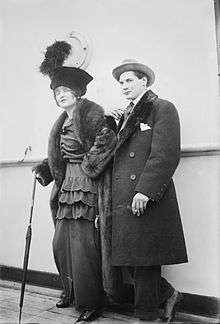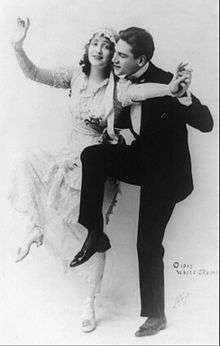Harry Pilcer
| Harry Pilcer | |
|---|---|
 Harry Pilcer with Gaby Deslys | |
| Born |
April 29, 1885 New York City, New York |
| Died |
January 14, 1961 (aged 75) Cannes, Alpes-Maritimes, France |
| Occupation | Actor, dancer |
| Years active | 1907–1946 |
| Partner(s) | Gaby Deslys |
Harry Pilcer (April 29, 1885 – January 14, 1961)[1] was an American actor, dancer, choreographer and lyricist.
Biography
Pilcer is mainly remembered for his association with French dancer and singer Gaby Deslys who may have been his wife.[2] According to Fred Astaire's autobiography, Pilcer was a fellow student at Claude Alvienne's stage dancing and dramatic school in New York in 1905.[3] Pilcer and Deslys appeared in four Broadway musicals together Vera Violetta (1911), The Honeymoon Express (1913), The Belle of Bond Street (1914) and Stop Look! Listen! (1916). He composed Deslys's waltz The Gaby Glide. As a dance team Pilcer and Deslys were contemporaries to Vernon and Irene Castle, Florence Walton and "Maurice", Dorothy Dickson and husband Carl Hyson, and Genevieve Lyon and her husband John Murray Anderson.[4] Pilcer and Deslys would probably have been the top dance team in both America and Europe had not World War I intervened and Deslys's death from influenza in 1920. Pilcer also danced with Mistinguett and Teddy Bernard. After 1922 Pilcer ran a school of dancing in Paris.[5] Pilcer co-starred with Deslys in her 1915 silent film Her Triumph (1915).
Pilcer died at Cannes of a heart attack January 14, 1961.[6]
Filmography
- Her Triumph (1915)
- Bouclette (1918)
- Le Dieu du hasard (1921)
- Distress (1929)
- An Ideal Woman (1929)
- Thank Your Lucky Stars (1943)
- The Razor's Edge (1946)
References

- ↑ Who Was Who on Screen, 3rd edition, p. 582 by Evelyn Mack Truitt c. 1983
- ↑ Silent Film Necrology 2nd edition, p.421 by Eugene Michael Vazzana c.2001
- ↑ Steps in Time by Fred Astaire, HarperCollins, c.1989, p.17
- ↑ Pictorial History of the American Theatre: 1860-1985 by Daniel Blum, page 149, c.1985 (updated edition)
- ↑ Who Was Who in the Theatre: 1912-1976 page 1,917, vol. 3 I-P, originally published annually by John Parker; this 1976 edition compiled by Gale Research
- ↑ Truit, p.582
External links
| Wikimedia Commons has media related to Harry Pilcer. |
- Harry Pilcer on IMDb
- Harry Pilcer at the Internet Broadway Database

- Pilcer, 1908 portrait (University of Washington, Sayre)
- Harry Pilcer and Gaby Desly, early in their teaming (probably taken in Europe)
- Pilcer in his heyday
- Harry Pilcer, 1920
- Photo of Pilcer in later years, appeared in his obituaries
- newsreel of Pilcer greeting friend Roscoe Arbuckle to London, 1920 *time marks 2:19 and 8:26